Driven to Succeed: How Racer Kurt Busch Muscled Up for His Indy-Charlotte Double

It was just after 10 p.m. on the night of Sunday May 25 when the number 41 Chevy exited the 1.5-mile oval of Charlotte Motor Speedway and rolled to a stop in front of its Stewart-Haas team hauler. In any other race this premature shutdown, after 271 of the race’s scheduled 400 laps, would’ve been ascribed to the car’s busted left rear shock and a V-8 engine that, for no clear reason, decided to become a six. But because this was the last leg of the Double—perhaps the most demanding event in motorsports, a 1,100-mile odyssey that begins with the Indianapolis 500 and ends with NASCAR’s Coca-Cola 600—one couldn’t help but wonder if maybe the driver had broken down too.
Kurt Busch knew the risks going in. Of the three drivers before him to attempt the high-octane one-two, only Tony Stewart, Busch’s boss and teammate, had made it to the final mile marker. And when he did in 2001—and finished sixth at Indy and third at Charlotte—they needed a stretcher to carry Stewart from his car and a hose to wash down the interior. Since then only one driver, Robby Gordon, has had the lug nuts to try the Double again; he was done in by a combination of rain, car trouble and, unsurprisingly, leg cramps.
Most observers figured Busch would fall somewhere on the stress meter between Gordon and Stewart after a frenetic afternoon at the Brickyard that saw him equal Stewart’s sixth-place finish, and a frantic early evening commute from Indianapolis to Concord, N.C., that Busch covered in a police cruiser, two helicopters and a Cessna Citation X. But after winding down his wounded engine and unbuckling himself from the cockpit, he slid out of the driver’s side window with ease. He was a bit sore, sure, but the pain was more emotional than anything. “We were hanging on,” said Busch after finishing 40th. “We were gonna muscle it out, but then the engine let go. Those things happen in motorsports. It was a good battle.”
The fact that he was not only still standing afterward but game to double up again in 2015—“I’d love to,” he said—is a credit to the five months’ of work he put in at Okinawan Karate Dojo, a small studio at the end of a strip mall just a 12-minute jog from Busch’s home in Ellicott City, Md., called.
The dojo’s 44-year-old Wharton educated proprietor—Stanley Crump, aka Sensei Stan—is an ex-pharmaceutical salesman turned karate master who trains pro athletes on the side. Crump, though, had never worked with a driver; when he accepted the job to train Busch ahead of the Double, Crump interviewed Busch at length. He came out with three pages of notes on the physical challenges he faced behind the wheel—which Busch narrowed down to his back, his hands and arms, and his heart—and, later, a thrice-weekly boot camp program designed to give the ’04 Cup champion a boost. Here’s a selection of sets from a workout in early May, each of which was followed by 15 seconds of rest:
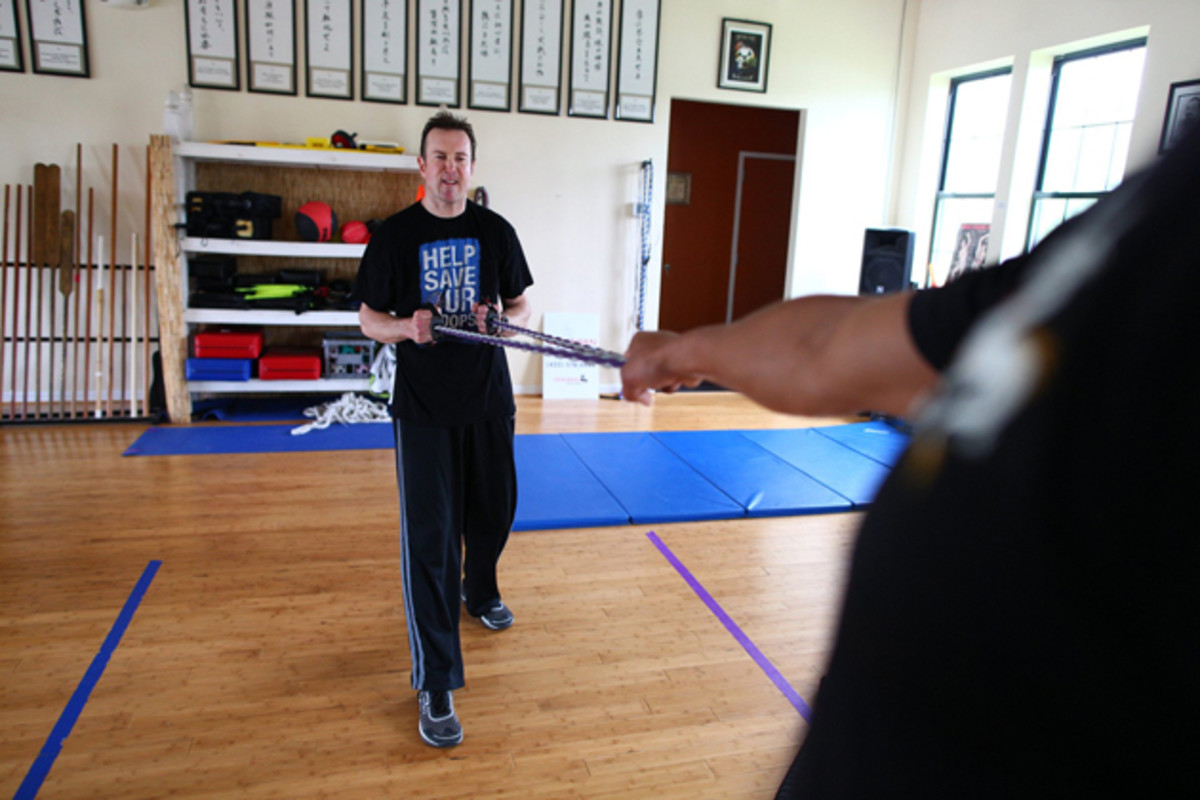
PULL AND SQUEEZE
In this drill, Busch, with his palms facing inward, pulls at one end of a pair of resistance bands Sensei Stan holds six to eight feet away. The pulling action engages his biceps, while the two- to three-second squeeze at the end of the pull engages “those often under-worked muscles of the back,” Crump says. This gives the upper back, he adds, “a better chance of sustaining better posture by helping to keep the shoulders pulled back.” Target: two sets, 20 reps with a two- to three-second squeeze after each pull.
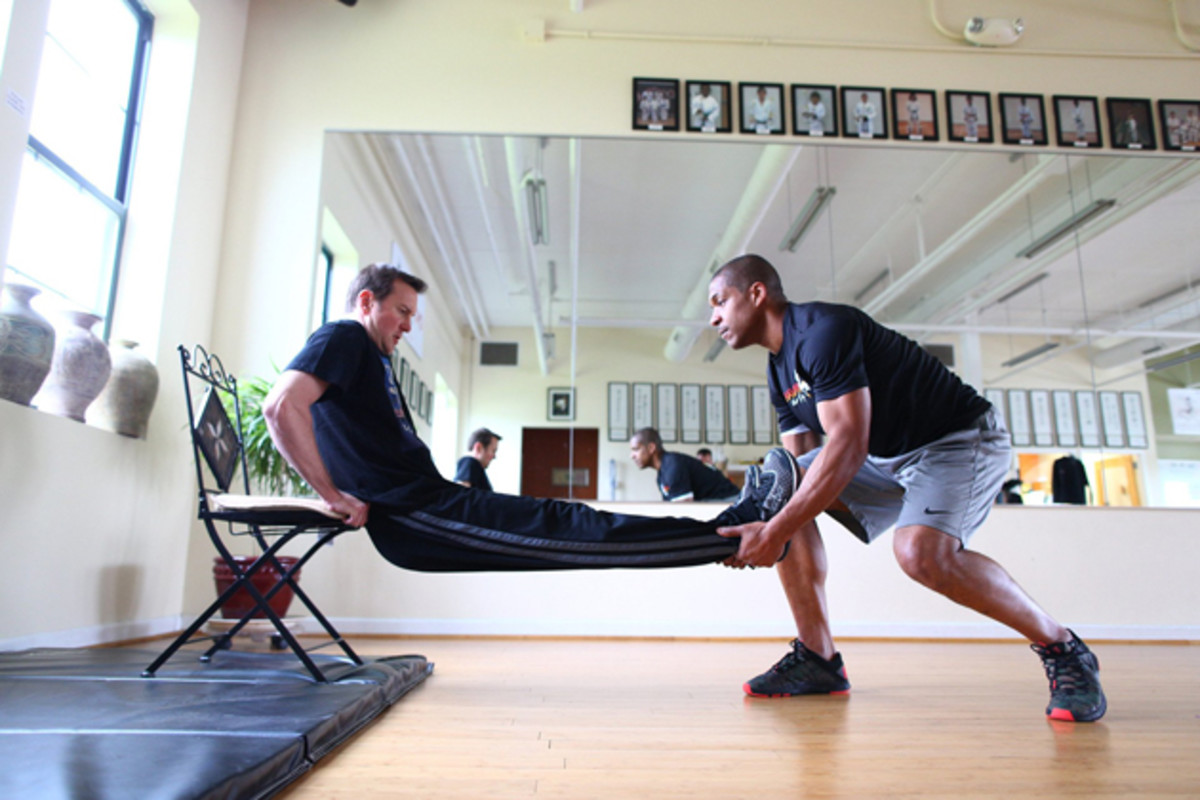
TRICEP DIP WITH ELEVATED LEGS/FEET
Busch doesn’t have to use a chair as a prop. (Any similarly elevated surface will do.) All that matters is that he uses his hands. “By supporting his weight on his hands and dipping down to the point where his upper arm goes to a 45-degree angle, the triceps are isolated, engaged, and strengthened,” Crump says. The farther outstretched Busch’s legs and feet are, “the more difficult the exercise becomes,” he adds. “By elevating his feet I was able to make the challenge that much more difficult because the full weight of Kurt's body rested on the work he was doing with his triceps.” Target: two sets, 25 reps.
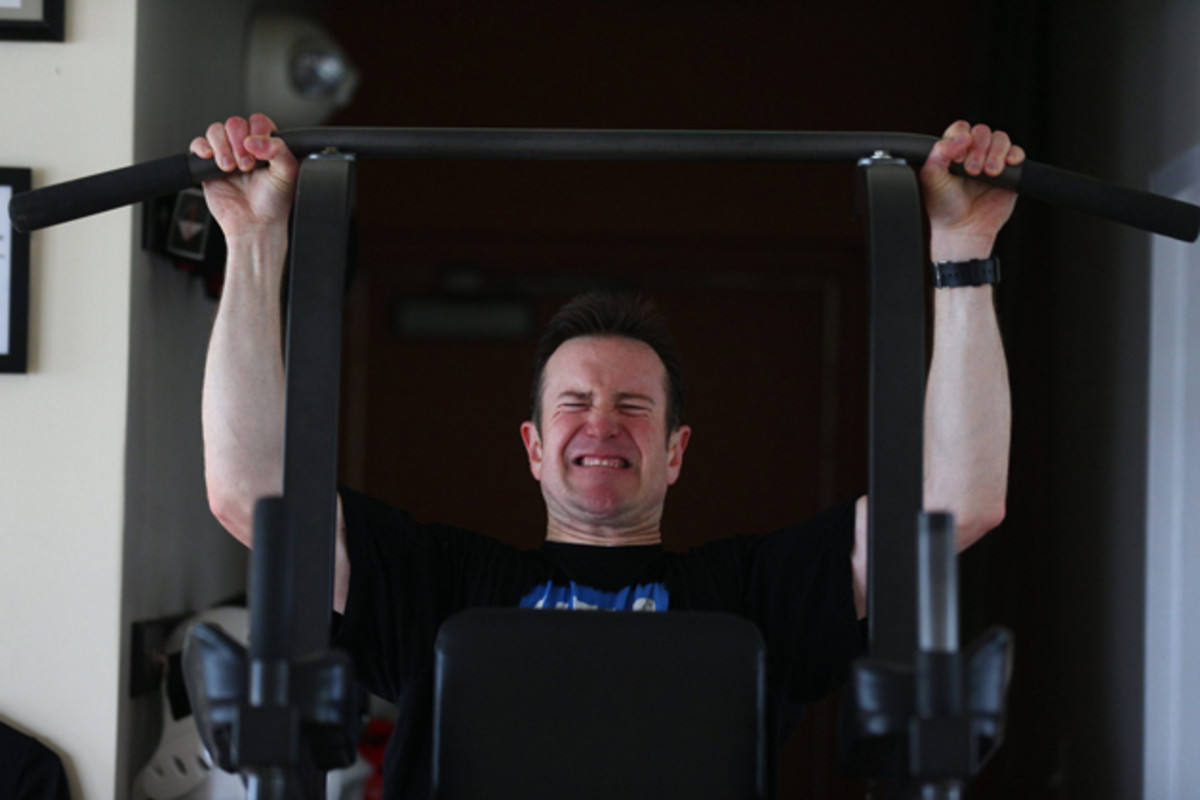
CHEST-UPS
It’s like a chin up—except instead of pulling his face to the bar, Busch has to get his sternum there. His back and shoulders benefit most, but that takes time for Busch. His years in racing have rendered those muscles as elastic as fingers balled up into a fist, effecting his posture. “With better posture, Kurt's body is able to breathe more efficiently under the duress of the race, move and respond in a more productive manner, and feel more comfortable in the tight confines of the car,” Crump says. Target: three sets of 10.
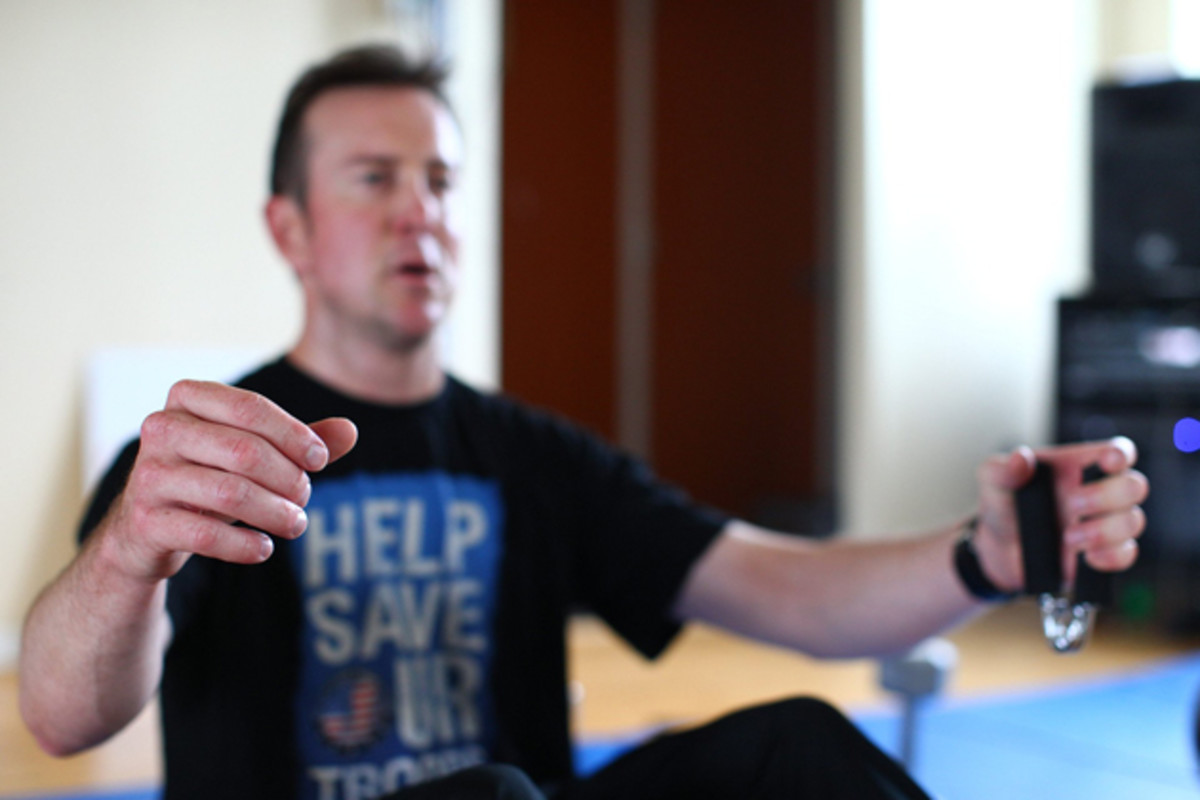
HAND GRIPS
In this drill Busch gives a tool meant for combating carpel tunnel syndrome another spin, using it to fortify his hands and forearms against the stresses of two different types of steering wheels—one that is power assisted (NASCAR) and another that isn’t (IndyCar).
“I had Kurt squeezing the grippers in two basic positions,” says Crump. “One with the coils up, to work the palms and core of his hand muscles; and another, with the coils down. I have seen this exercise done by my contemporaries in Okinawa. It forces you to isolate the pinky and ring finger—most important for total hand strength and grip. We often combined this part of Kurt's regimen with running, planks, crunches, and so on.” Target: two sets of 40 each with the handles down and up.
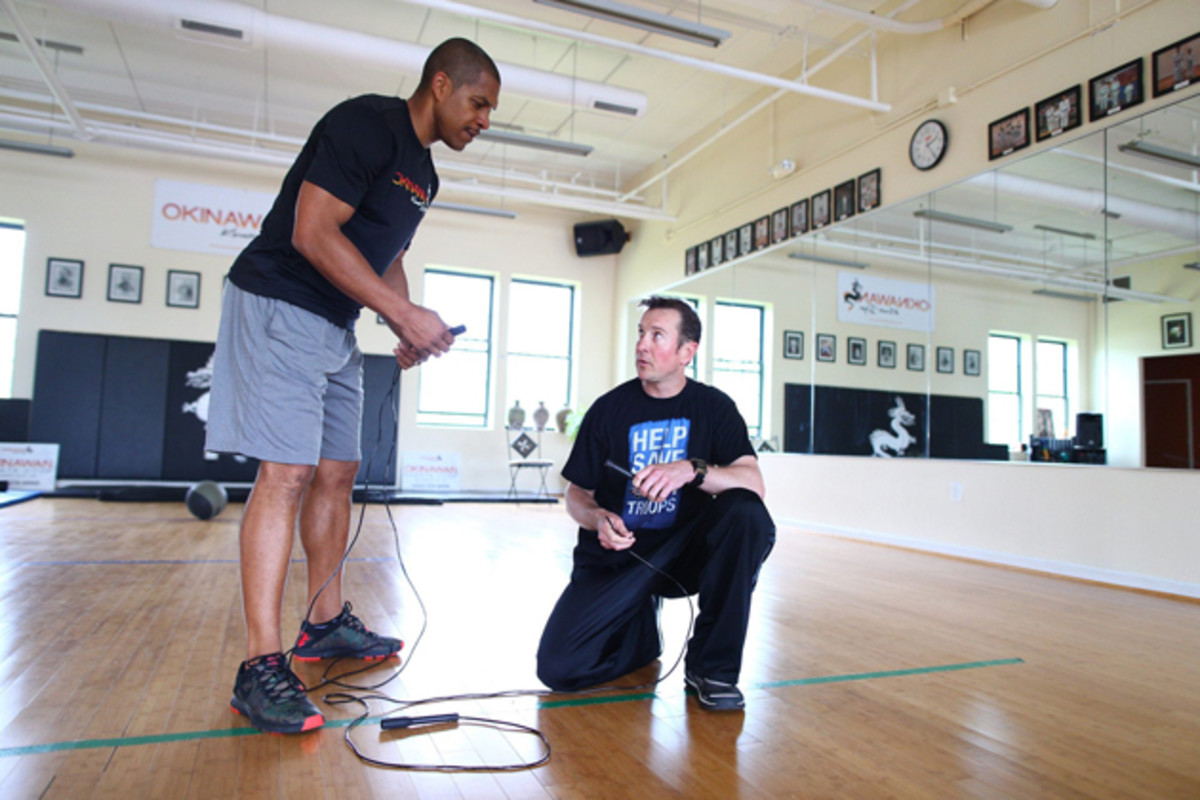
JUMP ROPE
Not only is this drill great for building stamina and agility, it’s portable—which was essential for Busch, who hopscotched between home, Indy and 11 stops on the Sprint Cup schedule before the Charlotte race. Just as Busch settles into a rhythm of one set, the one of the handles on one end of the rope breaks.
"Hard on equipment,” he cracks. “That’s the story of my life."
“In this situation,” Crump says, “you get to start over.”
“Yeah. We didn't wreck.”
After Crump dug out a spare, one of many over the course of their five months together, Busch was back in motion. While all his efforts didn’t carry him quite as far as he wanted to go on Memorial Day weekend, his body is no worse after the journey. It’s better. Target: two to three sets of 200 to 300 jumps.
